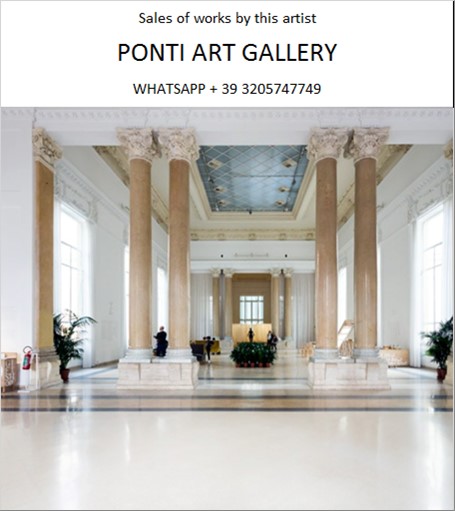Ponti Art Gallery is interested in buying and selling works
of art by this artist.

Alberto Martini Biography
Alberto Martini was an Italian artist whose work spanned the late 19th and early 20th centuries, a period marked by significant cultural and artistic transitions. Born on November 24, 1876, in Oderzo, Veneto, Martini was the son of Giorgio Martini, a professor of design at the Technical Institute of Treviso. From a young age, Alberto was immersed in an environment that valued artistic expression, receiving his early training in drawing and painting from his father.
Martini's artistic journey began in earnest when, at the age of 21, he exhibited for the first time at the Venice Biennale. This marked the start of a long association with the Biennale, where his works would be featured for 14 consecutive years. His early work was influenced by the German sixteenth-century mannerism of artists like Dürer and Baldung, but he soon developed a personal and refined symbolism, supported by his exceptional knowledge of iconography.
In 1898, Martini's career took a significant turn when he moved to Munich to collaborate with magazines. There, he met the Neapolitan art critic Vittorio Pica, who became a lifelong supporter and promoter of Martini's work. Pica's influence was instrumental in shaping Martini's career, and he often provided opportunities for the young artist, including commissions for the review "Emporium."
Martini's graphic production was vast and varied, including engravings, lithographs, ex libris, watercolors, business cards, postcards, and book illustrations. He illustrated works for a range of literary figures, from Dante to D’Annunzio, from Shakespeare to Victor Hugo. One of the peaks of his art was the series of Indian ink illustrations for Edgar Allan Poe’s short stories, showcasing his strong visionary talent and moving away from the meticulous realistic observation of his earlier works.
During World War I, Martini published a series of postcards entitled "Danza Macabra Europea," consisting of 54 lithographs that served as satirical propaganda against the Austro-Hungarian empire. These works distributed among the allies, demonstrated Martini's grotesque and boundless fantasy, and positioned him as a precursor of Surrealism.
Despite his prolific output and the originality of his work, Martini never gained the recognition he deserved within the Italian early-twentieth-century art scene. His eclectic nature, which avoided easy categorization, and his originality, which he considered an asset, paradoxically forced him to remain a peripheral and occult artist. His work was emblematic of the cultural transition between nineteenth-century romantic decadentism and the new, darker urgencies that erupted with the First World War.
Martini's work gave voice to existential tensions that would later lead to surrealism and metaphysical art. He shared a kinship with contemporaries like Alfred Kubin, with whom he shared unreal imagery and a macabre trait. Martini's art was strongly emblematic of the cultural transition from nineteenth-century romantic decadentism to the new, darker urgencies that erupted with the First World War.
Alberto Martini's legacy is preserved in part by the Civic Art Gallery of Oderzo, which is dedicated to his work and promotes the study of his contributions to art. His remains, along with those of his wife Maria Petringa, lie in the cemetery of Oderzo, a testament to the life of an artist who lived in dreams and considered those who did so to be superior beings.
Martini continued to paint with considerable expressive effect until the end of his life. He died in Milan on November 8, 1954, leaving behind a body of work that continues to be studied and appreciated for its visionary qualities and its place in the history of art. His work remains a testament to an artist who, despite the lack of recognition during his lifetime, created a unique and enduring legacy that continues to inspire and captivate audiences today.
Alberto Martini Quotes and
Sales of Works
Ponti Art Gallery selects and deals with paintings by the
artist. Upon request, we provide free estimates and
evaluations, communicate prices, quotations, and current
market values.
If you are interested in BUYING or SELLING works by the
artist, contact us immediately.
If you wish to sell or receive an evaluation of the
works:
Send us a frontal photo of the painting, one of the back,
and one of the signature. Also, indicate the dimensions of
the work. Inform us about the purchase origin of the work
and any kind of available documentation (purchase
receipts, certificates of authenticity, publications). One
of our operators will respond to you on the same day. We
guarantee maximum confidentiality and extreme
professionalism.
If you wish to purchase works by the painter: Contact us
and let us know your request. We will inform you about the
available works. We also offer the possibility to
subscribe to our NEWSLETTER, through which you will be
informed at the beginning of each month about the latest
acquisitions of the art gallery.
You can send us pictures of the work:
